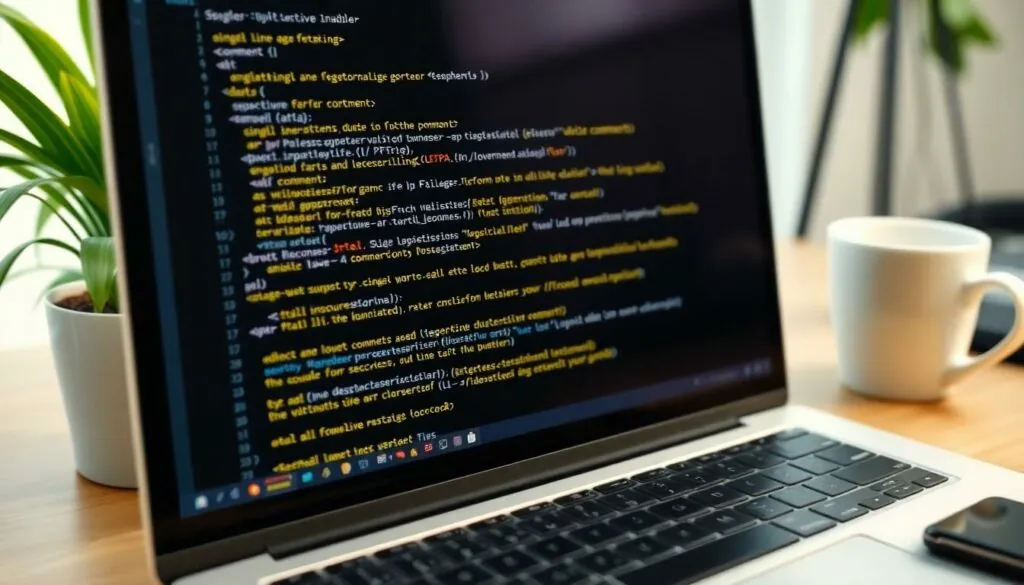In the world of Python programming, commenting out code is like putting a “Do Not Disturb” sign on your brain. It keeps your thoughts organized and helps others understand your genius without the clutter. Whether you’re debugging or just trying to leave a note for your future self, knowing how to comment effectively is crucial.
Table of Contents
ToggleUnderstanding Comments in Python
Comments in Python serve as annotations within the code. These annotations help clarify complex logic, making it easier for programmers to understand the purpose and functionality of specific sections. Two primary types of comments exist in Python: single-line comments and multi-line comments.
Single-line comments begin with a hash symbol (#). Anything following the hash symbol on that line is ignored by the interpreter. Programmers often use this format to leave brief explanations or notes about the code. For example:
# This prints Hello World
print("Hello World")
Multi-line comments, often enclosed within triple quotes (”’ or “””), allow for longer explanations or documentation. While Python interpreters disregard this format as well, it remains useful for providing detailed descriptions or disabling large code blocks temporarily. An example of this format is:
"""
This is a multi-line comment.
It provides extensive documentation
about the code that follows.
"""
Effective commenting enhances code readability and maintainability. It allows developers to communicate their intentions clearly and reduces the likelihood of confusion during collaborative projects. Comments also simplify debugging processes, guiding programmers through identifying and solving errors.
Optimizing comments fosters an organized coding environment. Clear and concise comments can significantly aid in auditing and updating code, ensuring that future developers can easily navigate and understand the existing code structure. Implementing proper commenting techniques contributes to high-quality Python programming and elevates overall codebases.
Types of Comments

Python provides two main types of comments that enhance code clarity: single-line comments and multi-line comments. Each serves a distinct purpose in documenting code effectively.
Single-Line Comments
Single-line comments start with a hash symbol (#). They serve to provide quick explanations or notes directly next to the code. Programmers often use them to clarify a specific line or a small block of code. For instance:
# This function adds two numbers
def add(a, b):
return a + b
In this example, the comment succinctly explains the purpose of the function. Keeping single-line comments concise aids in maintaining code readability and facilitates easier understanding for other developers or future reference.
Multi-Line Comments
Multi-line comments use triple quotes (”’ or “””). These comments allow developers to include more extensive documentation or explanations that span several lines. They often describe the functionality of a module or function in detail. For example:
'''
This function calculates the square of a number.
It takes a single argument and returns its square value.
'''
def square(x):
return x * x
The above example illustrates how multi-line comments can provide comprehensive information. Using multi-line comments encourages thorough documentation, which is vital for larger projects or when collaborating with other programmers.
How to Comment Out in Python
Commenting in Python improves code clarity and organization. Effective comments guide others through the code, enhancing readability and understanding.
Using the Hash Symbol
Single-line comments start with a hash symbol (#). Place the hash before the comment text, and Python ignores everything that follows on that line. Developers often use these comments for brief notes or explanations. For instance, a quick description of a function can fit nicely on the same line, making the intention clear without cluttering the code. A well-placed comment can explain specific logic or highlight important points, turning complex code into something more approachable.
Using Triple Quotes
Multi-line comments utilize triple quotes (”’ or “””). Enclose the comment text within these quotes, allowing for longer annotations that span several lines. Programmers rely on this style for extensive documentation, especially in larger projects. When detailing the functionality of a module or function, multi-line comments provide necessary context that single-line comments cannot. Using these comments effectively promotes collaboration, as it offers team members comprehensive insights into the code’s purpose and design strategy.
Best Practices for Commenting Code
Effective commenting enhances code clarity and provides valuable insights for developers. Prioritize brevity and relevance in comments to ensure they add contextual value. Use single-line comments for brief notes that explain specific lines of code, maintaining clarity without overwhelming details. Multi-line comments serve well for providing comprehensive explanations, especially in complex functions or modules.
Focus on writing meaningful comments that explain the “why” behind code, not just the “what.” This approach clarifies intentions, making the codebase easier to understand during collaboration or future modifications. Moreover, consistency in commenting style is crucial for maintaining code readability across projects.
Employ clear language and avoid jargon unless it’s universally understood within the team. Integrate comments close to the relevant code to avoid confusion. When commenting on functions, include information such as parameters, return values, and examples of usage.
Regularly update comments as code evolves to prevent misinformation. This practice maintains the integrity of documentation and ensures that comments remain relevant to the current codebase. Overall, following these best practices fosters an organized coding environment and simplifies future debugging efforts. By prioritizing informative, concise comments, developers contribute to a more maintainable and collaborative programming process.
Common Mistakes to Avoid
Omitting comments entirely is a frequent mistake. Comments serve as essential guides that clarify code intentions, particularly in complex segments. Failing to document steps can leave others guessing about the code’s functionality.
Overusing comments also poses a challenge. Excessive commentary can clutter the code and distract from its purpose. Striking a balance between explanation and code clarity enhances readability.
Using vague language in comments is another pitfall. Comments should convey clear meanings and avoid ambiguity. Specificity helps others understand the rationale behind coding decisions.
Misplacing comments can disrupt the flow. Placing comments too far from the relevant code reduces their effectiveness. Integrating comments directly with related lines improves comprehension.
Neglecting to update comments can lead to confusion. As code evolves, comments must reflect those changes. Regular updates ensure that commentary stays relevant and accurate.
Inconsistencies in commenting style can create confusion. Uniformity in format and tone fosters better communication among developers. Adhering to a consistent convention simplifies collaboration.
Relying solely on comments for explaining complex functionality is risky. Code should be written clearly enough to minimize the need for explanations. Prioritizing clarity in code reduces reliance on comments while maintaining necessary documentation.
Mastering the art of commenting in Python is vital for any programmer. It not only enhances code readability but also fosters collaboration among developers. By using single-line and multi-line comments effectively, programmers can clarify their intentions and simplify complex logic.
Sticking to best practices ensures comments remain relevant and valuable. Regular updates and a consistent style further enhance communication within teams. Avoiding common pitfalls like vague language or excessive comments will lead to a cleaner codebase.
Ultimately, thoughtful commenting transforms code into a more organized and maintainable resource, making it easier for both current and future developers to navigate and understand.






